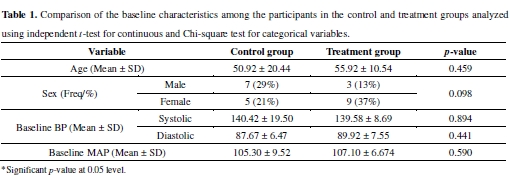Sweet basil leaves as adjunct therapy for stage 1 and 2 hypertension: a pilot clinical trial
Abstract
Ocimum basilicum L. (Sweet Basil) is a medicinal herb used in traditional Indian and Chinese medicine to treat a variety of disease conditions including hypertension, and has well established antihypertensive effects among renovascular hypertensive rats. The aim of this study was to evaluate the antihypertensive effects of O. basilicum as adjunct in the management of stage 1 and 2 hypertensive patients. A double blind-randomized controlled trial was performed, with participants (n=24) randomized into a control and treatment group. Participants randomized into the control group (n=12) were given their prescribed antihypertensive medication plus placebo while those in the treatment group (n=12) were given their antihypertensive medication plus Ocimum basilicum L. capsules containing 128 mg of dried, powderized leaves once a day. Participants’ blood pressure (BP) was measured at baseline, 1 week, and 2 weeks of drug administration and the Mean Arterial Pressure (MAP) calculated. Results showed that systolic and diastolic BP in the treatment group measured from baseline, one and two weeks of drug administration are significantly different, whereas the control group had insignificant findings. Furthermore, the MAP in the control group (105.25±9.52 mm/Hg, 104.08±8.45 mm/Hg and 104.47±8.85 mmHg) were comparable while that in the treatment group (106.47±6.65 mm/Hg,100.89±9.99 mm/Hg, and 97.14±9.96 mm/Hg) showed significant lowering (p=<0.0001) over time by Repeated Measures-Anova with Bonferroni’s post-hoc test. The significant findings in this study support the antihypertensive action of Ocimum basilicum L. among humans which warrant further exploration.
References
2. Beevers G, Lip GY, O’Brien E. ABC of hypertension: The pathophysiology of hypertension. BMJ. 2001; 322(7291): 912-916.
3. Alves RRN, Rosa IL. Why study the use of animal products in traditional medicines? J Ethnobiol Ethnomed. 2005; 1(1): 5.
4. Ekor M. The growing use of herbal medicines: issues relating to adverse reactions and challenges in monitoring safety. Front Pharmacol. 2014; 4: 177.
5. Bilal A, Jahan N, Ahmed A, Bilal SN, Habib S, Hajra S. Phytochemical and pharmacological studies on Ocimum basilicum Linn - A review. Int J Curr Res Rev. 2012; 4(23): 73-83.
6. Janbaz KH, Hamid I, Gilani AH, Qadir MI. Spasmolytic, bronchodilator and vasodilator activities of aqueous-methanolic extract of Ocimum basilicum. Int J Agric Biol. 2014; 16(2): 321-327.
7. Interaminense LFL, Jucá DM, Magalhães PJC, Leal‐Cardoso JH, Duarte GP, Lahlou S. Pharmacological evidence of calcium‐channel blockade by essential oil of Ocimum gratissimum and its main constituent, eugenol, in isolated aortic rings from DOCA‐salt hypertensive rats. Fundam Clin Pharmacol. 2007; 21(5): 497-506.
8. Peixoto-Neves D, Leal-Cardoso JH, Jaggar JH. Eugenol dilates rat cerebral arteries by inhibiting smooth muscle cell voltage-dependent calcium channels. J Cardiovasc Pharmacol. 2014; 64(5): 401.
9. Kaplan C. Clinical methods: the history, physical, and laboratory examinations, 3rd edn. Boston: Butterworths; 1990. Chapter 155.
10. Anjos PJ, Lima AO, Cunha PS, De Sousa DP, Onofre AS, Ribeiro TP, et al. Cardiovascular effects induced by linalool in normotensive and hypertensive rats. Zeitschrift Naturforschung C. 2013; 68(5-6): 181-190.
11. Kang P, Seol GH. Linalool elicits vasorelaxation of mouse aortae through activation of guanylyl cyclase and K+ channels. J Pharm Pharmacol. 2015; 67(5): 714-719.
12. Camargo SB, Simoes LO, de Azevedo Medeiros CF, de Melo JA, Fregoneze JB, Evangelista A, et al. Antihypertensive potential of linalool and linalool complexed with β-cyclodextrin: Effects of subchronic treatment on blood pressure and vascular reactivity. Biochem Pharmacol. 2018; 151: 38-46.
13. Umar A, Imam G, Yimin W, Kerim P, Tohti I, Berke B, et al. Antihypertensive effects of Ocimum basilicum L. (OBL) on blood pressure in renovascular hypertensive rats. Hypertens Res. 2010; 33(7): 727-730.
14. Amrani S, Harnafi H, Gadi D, Mekhfi H, Legssyer A, Aziz M, Martin-Nizard F, Bosca L. Vasorelaxant and anti-platelet aggregation effects of aqueous Ocimum basilicum extract. J Ethnopharmacol. 2009; 125(1): 157-162.
15. Chobanian AV, Bakris GL, Black HR, Cushman WC, Green LA, Izzo Jr JL, et al. Seventh report of the joint national committee on prevention, detection, evaluation, and treatment of high blood pressure. Hypertension. 2003; 42(6): 1206-1252.
16. Awasthi H, Mani D, Nath R, Nischal A, Usman K, Khattri S. Standardization, preparation and evaluation of an Ayurvedic polyherbal formulation in capsule dosage form suitable for use in clinical trials. Indo Am J Pharm Res. 2014; 4(10): 4093-4099.
17. Ambrose DC, Manickavasagan A, Naik R, eds. Leafy medicinal herbs: botany, chemistry, postharvest technology and uses. CABI, 2016.
18. Nair AB, Jacob S. A simple practice guide for dose conversion between animals and human. J Basic Clin Pharmacy. 2016; 7(2): 27.
19. Labra M, Miele M, Ledda B, Grassi F, Mazzei M, Sala F. Morphological characterization, essential oil composition and DNA genotyping of Ocimum basilicum L. cultivars. Plant Sci. 2004; 167(4): 725-731.
20. Krüger H, Wetzel SB, Zeiger B. The chemical variability of Ocimum species. J Herbs Spices Med Plants. 2002; 9(4): 335-344.
21. Karpiński TM. Essential oils of Lamiaceae family plants as antifungals. Biomolecules. 2020; 10(1): 103.
22. El-Bassossy HM, Elberry AA, Ghareib SA. Geraniol improves the impaired vascular reactivity in diabetes and metabolic syndrome through calcium channel blocking effect. J Diabetes Complic. 2016; 30(6): 1008-1016.
23. El-Bassossy HM, Ghaleb H, Elberry AA, Balamash KS, Ghareib SA, Azhar A. Geraniol alleviates diabetic cardiac complications: effect on cardiac ischemia and oxidative stress. Biomed Pharmacother. 2017; 88: 1025-1030.
24. Santiago JVA, Jayachitra J, Shenbagam M, Nalini N. D-limonene attenuates blood pressure and improves the lipid and antioxidant status in high fat diet and L-NAME treated rats. J Pharmac Sci Res. 2010; 2(11): 752.
25. Jing L, Zhang Y, Fan S, Gu M, Guan Y, Lu X, Huang C, Zhou Z. Preventive and ameliorating effects of citrus D-limonene on dyslipidemia and hyperglycemia in mice with high-fat diet-induced obesity. Eur J Pharmacol. 2013; 715(1-3): 46-55.


This work is licensed under a Creative Commons Attribution 4.0 International License.



